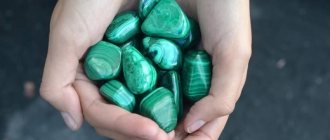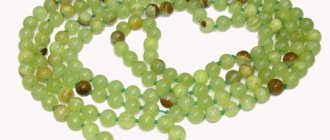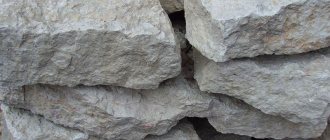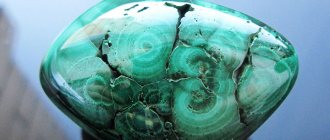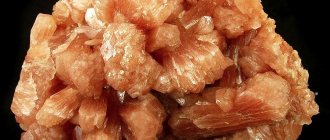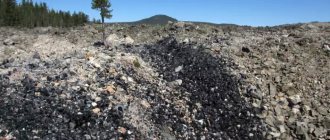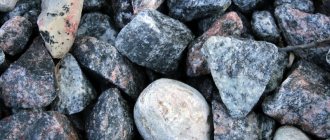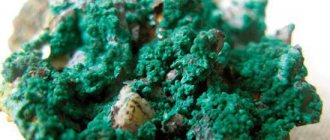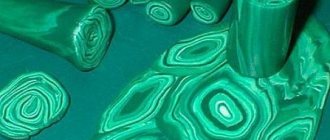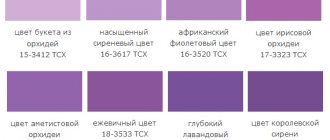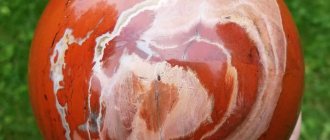Malachite is one of the most beautiful minerals. According to A.E. Fersman, ego is “a stone of bright, juicy, cheerful and at the same time silky-delicate greenery.” Its color is a palette of green tones from light green with blue (turquoise) to thick dark green (“velvet”).
This mineral has long attracted people's attention. The ancient Greeks decorated elegant buildings and halls with malachite. In Ancient Egypt, cameos, amulets and jewelry were made from malachite, mined on the Sinai Peninsula. However, this mineral gained true fame after the discovery of large deposits of malachite at the end of the 18th century. in the Urals.
Chemical composition
Contains: Copper oxide CuO - 71.59% (Cu - 57.4%), carbon dioxide (CO2) 19.90%, water (H20) 8.15%.
Natural malachites usually meet this composition. CaO, Fe2O3, SiO2, etc. are also found in very small quantities. Their presence is obviously due to adsorbed or mechanical impurities of foreign substances.
Varieties
1. Copper green - earthy soft malachite.
Crystallographic characteristics
Monoclinic system
Symmetry class. Prismatic 2/m? V. With. Etc. gr. P21/a(C 52h). a0 = 9.49; b0 = 12.00; с0 = 3.24, β = 98°42′. Axle ratio. 0.788: 1: 0.274; Z = 4.
The main forms of crystals are a {100}, m {110}, b {010} and p {201}.
Malachite. Kidney-shaped aggregate. Zaire
How to distinguish natural malachite from a fake
Malachite beads.
Photo: charm-beads.ru The likelihood of encountering products made from pressed malachite is low, since the process of making a fake is much less profitable than using natural stone. If doubts arise, then you can look at the drawing. In natural malachite it will be naturally concentric. This means that the stripes and circles are arranged in a circle. In a fake stone, the pattern will be interrupted.
Advertising - Continued below
There is, of course, another way to verify the authenticity of a stone - with a drop of acid. But in this case, the malachite will be hopelessly damaged.
Form of being in nature
The appearance of crystals. Malachite crystals are rare, usually prismatic [001]. Short and long prismatic, needle-shaped.
{100} doubles are common.
Aggregates. Malachite
most often forms sinter, kidney-shaped, grape-shaped aggregates, earthy masses (copper greens), and plaques. Sometimes it forms fibrous radial aggregates with a characteristic silky sheen.
Sintered forms of malachite occur in karst caves and cavities of ore-bearing limestones, into which water containing copper bicarbonate is filtered.
Large kidney-shaped spherulite formations of malachite are characterized by a concentric-zonal structure, which is especially impressive on polished samples.
The texture of malachite is varied - ribbon, streamy, concentrically circular, radiant-star-shaped with alternating layers of different colors.
Names of the stone
One of the translations from Greek for the name of the stone is the word “soft”. We can say that this word contains a brief description of the structure of the stone, because it is indeed very fragile and malleable when processed.
People also called it “mallow” and “grass” because of the obvious similarity of its color to green grass. Another popular and beautiful folk name for the mineral is peacock eye. This description of malachite was a kind of folk reflection of the diversity of its colors and the uniqueness of its geometric patterns.
Physical properties of malachite
Optical
- The color of malachite is bright green, dark green, grass green, emerald green. Its color is explained by the presence of copper ion.
- The streak is pale green.
- Shine. Glass.
- The shimmer is silky, matte.
- Transparency. Translucent, opaque.
- Refractive indices: Ng = 1.909, Nm = 1.875 and Np = 1.655.
Mechanical
- Hardness. 3.5-4, fragile.
- Density. 3.9-4.1.
- Cleavage in crystalline varieties rarely appears; in these cases, perfect according to {201} corresponds in the structure to planes from CO3 groups? by {010} average.
- Kink. Conchoidal, earthy, uneven.
Chemical properties
Behavior in acids. It dissolves easily in HCl (with boiling); with abundant addition of ammonia, the solution turns blue.
Malachite. Russian mosaics
Diagnostic signs
Similar minerals . Chrysocolla, atacamite, copper phosphates and arsenates, etc.
Easily recognized by its characteristic green color, frequently observed sintered forms and radial fibrous structure. We can distinguish green copper minerals from somewhat similar chrysocolla (copper hydrosilicate), pseudomalachite (copper phosphate) and other green copper minerals by their behavior in hydrochloric acid (it releases carbon dioxide).
Associated minerals. Chalcopyrite, bornite, tetrahedrite, chalcocite, cuprite, native copper, azurite, hematite, limonite, calcite.
DESCRIPTION AND PROPERTIES OF STONE
Malachite is a mineral with a rich emerald color. For decades, they refused to classify it as a separate category due to the large proportion of copper (56%) in its composition. Finally, in 1747, Swedish scientists provided evidence that allowed malachite to be considered a separate species.
Whether it is a precious stone or not can be determined based on the gemological classification of Professor Kievlenko: malachite belongs to the second group of ornamental, or stone-cutting, minerals: the so-called “semi-precious”.
Origin and species
Origin
The gem was first described by a scientist who was not directly involved in gemology. Chappe d'Auteroche was an astronomer and carried out astronomical work in the Ural Mountains. Admiring malachite, he was able to describe it in such detail that he glorified it throughout Europe.
The stone was named after the mallow plant. The stems and leaves of mallow are as rich in color as green malachite.
The stone has a long history: for example, during excavations in Jericho, the oldest malachite beads were found. From the point of view of archaeologists, they are more than nine thousand years old.
People of the Middle Ages used the gem to decorate their homes and temples.
Women of ancient Egypt used the powdered gem as eye shadow and eyeliner.
In Egypt, the gem was patronized by the goddess Hathor, the protector of all living things. Therefore, in ancient times, malachite amulets hung over every child's cradle.
Kinds
Malachite is a stone that mineralogy divides into types according to the type of structure and color.
Varieties of malachite are always fibrous in structure, with a wide variety of natural variations and formations:
- spherocrystalline shape variation;
- spherulite;
- spheroidolite;
- cluster formation of spheroidolites;
- kidney-shaped aggregate;
- pseudostalactite.
Malachite has different levels of transparency, depending on the size of the stone: the larger and heavier the sample, the less transparent it is.
Colors
There are 5 types of malachite color, and each has its own unique pattern:
| Plush | A stone with a wavy-banded structure and a silky sheen |
| Turquoise | A bluish-green stone with concentric stripes. The most popular is turquoise malachite interspersed with a subtle pattern called “peacock eye” |
| Radiant | A stone in which there is an alternation of dark green layers with light grassy layers |
| Nodular | A gem whose design has alternating dark layers surrounded by light layers in the form of a circle |
| Azur-malachite | A stone that combines emerald-colored malachite with dark blue azurite |
We recommend: ALBITE - “moon” stone
Composition and physical properties
The physical properties of the mineral are determined by its shallow depth: it is located in the surface layers of the soil.
WHY IS MALACHITE GREEN
Malachite is formed from ore deposits.
100 tons of ore = 1 kg of malachite
If we look at unprocessed malachite, we will see only an amorphous mass of a greenish-dirty color: it looks like some kind of deposits of unknown origin. Moreover, there are stones that resemble bunches or fluffy needle-shaped spheres (prismatic, lamellar and needle-shaped).
Characteristics of the stone
Composition : Cu oxide (71.9%) + carbon dioxide CO2 (19.9%) + water H2O (8.2%)
Chemical formula : Cu2{CO3}2(OH)2
The original name of the stone, “carbonated copper green,” is outdated.
Basic properties of malachite:
- Dissolve in acid.
- During the dissolution process, carbon dioxide is released.
- The largest malachite crystals are opaque.
- All small crystals are transparent.
- The stone has a hardness rating on the Mohs scale of 3.5 or 4.
- The mineral has a specific gravity of 3.9 – 4.14.
- The density of the stone is from 3.75 - 3.95 to 4.1.
When sold, malachite is often described as “pressed”. The pressed mineral, despite its natural origin, is low-grade. These are splinter fragments left over from processing a large stone, which were joined using epoxy resin.
How is it formed and mined?
Malachite in nature is formed as a result of long complex processes.
Method of education
- Weathering of copper from sulfide ore deposits occurs.
- Then copper, penetrating into the soil and water with a high content of hydrogen and carbon dioxide, mixes with them.
- Malachite itself is formed only when the resulting mineral solution passes through porous rock and is absorbed into it.
You can also find such a way of birth of a mineral as malachite stalactites and stalagmites. They are located in the depths and appear as a result of the evaporation of a natural solution in underground conditions.
Where is malachite mined in Russia and in the world?
The largest locations are located:
- In Russia, in the Urals, near Nizhny Tagil.
- In the Republic of Zaire.
- In Namibia.
- In France.
- In Rhodesia.
It is the Ural malachite that has received the highest praise throughout the world, as it has a wide range of colors and exceptional pattern texture. But its most valuable feature is the irregular shape of the spherical pattern: it is this that allows you to obtain unique patterns when cutting.
Unlike the Ural, African and French minerals have a different pattern: their patterns are regular, almost perfect concentric rings. They are distinguished by their density, clarity and purity: many experts consider such stones to be quite boring.
In the Urals, malachite mining began in 1760, from the moment the Gumeshevsky copper mine was acquired by Alexey Turchaninov. After he gave Empress Catherine a piece of incredibly beautiful malachite in 1789, which delighted her, the popularity of the mineral increased sharply.
Unfortunately, today the Ural deposits are depleted, and the main production is concentrated in Africa.
Under Catherine, Ural craftsmen made a technological breakthrough in mineral cutting. The stone cutting technique is called “Russian mosaic”: it allows you to fully reveal and show the beauty of the gem. This technique is still used today. We recommend: ROCK CRYSTAL - icy breath of the earth
Origin and location
Malachite is formed exclusively in oxidation zones of copper sulfide deposits, especially if they occur in limestones, or if the primary ores contain a lot of carbonates. It is the most common copper mineral in oxidized copper ores. It develops both by replacing carbonates and by filling voids with the formation of typical spherulitic forms in them. Since a clearly alkaline environment is created in solutions near the surface of limestones or carbonates of Ca and Mg, the solutions of copper sulfates that reach them obviously undergo hydrolysis, reacting with bicarbonate solutions.
In addition, copper carbonates can probably also arise as a result of the slow reaction of copper sulfate or hydrate with a solution saturated with atmospheric carbon dioxide. Malachite often forms pseudomorphs on azurite, cuprite, native copper, and sometimes also on minerals such as atacamite, calcite, chalcopyrite, etc. Malachite in the form of inclusions or “copper green” impurities is very often found in oxidation zones of copper deposits. However, large accumulations, especially of ornamental varieties, are now becoming rare.
Malachite (often together with azurite) is a typical prospecting mineral when searching for primary copper ores.
How to wear and care properly
There are no special rules for wearing malachite amulets. The main thing is to harmoniously combine the color with clothes and take into account compatibility with other stones. Silver and cupronickel are used as frames. A green stone set in gold looks ugly.
Attention! To maximize the magical properties of malachite, you should buy it in spring or summer. A talisman purchased during the cold season cannot fill the owner with vitality.
If the stone is used for healing, it is cleaned regularly. To do this, it is buried overnight in the ground in which flowers grow (or in a pot). In order for a fragile mineral to last longer, it needs to be properly cared for:
- do not drop;
- do not expose to sudden temperature fluctuations;
- do not scratch;
- clean with soapy water, wipe with a soft cloth;
- Do not use household or acid-containing chemicals for cleaning.
Malachite is an amazingly beautiful stone that has absorbed the power of mother earth. Suitable for both creative and business people, it enhances positive character traits, protects from evil and troubles, helps to establish contact with people around you, and move towards your goal. You just need to believe in his magical power and sincerely ask for help.
History of mining in Russia
It should be noted that malachite was first found in the foothills of the Urals in 1635 and was used to smelt copper from it). In the Ural copper mines, malachite began to be mined in large quantities. In the 19th century At the Mednorudnyansky and Gumishevsky mines, up to 80 tons of beautiful stone from light green to satiny dark green color were mined annually.
The discovery of the Ural deposits of malachite occurred at a time when the new capital of the Russian state was being built and noble people of the state vied with each other to outdo each other with the luxury and splendor of the decoration of their homes. Initially, when malachite was still scarce, it was used only for brooches, pendants, necklaces and other small items. However, when large pieces of malachite began to appear, a desire arose to use it as a decorative material. This was especially facilitated by the discovery at the end of the 18th century of the “Russian mosaic” method, which, when applied to malachite, gave remarkable results.
The organization of the Ural mining industry dates back to the first half of the 18th century. One of the first mining enterprises was the Nizhne-Tagil Demidov plant, built in 1725 on the Vysokogorsk iron ore discovered in 1696. On May 7, 1697, clerk Vinius wrote to Peter about this ore: “I found very good ore from magnetite, which is impossible to be iron.” To the south of the Vysokogorsky mine, a copper and magnetite deposit was discovered in 1720, which was named Mednorudyansky; Now they began to exploit it for the needs of the nearby Vyisky copper smelter. In 1760, during his travels around Russia, P. S. Pallas visited Nizhny Tagil. He writes that here “substantial copper ores were mined,” and in two mines “they broke not only white clay, but also significant buds of malachite, which in position and clay were in every way similar to the rich ores of the Gumeshevsky mine.” It should be noted that the owners of the copper mine did not attach any importance to malachite, although it was much more expensive than ordinary copper ores. The exploitation of the copper-poor Mednorudyanskoye deposit was unprofitable, and it was soon abandoned. The new discovery of this mine took place in 1813. The first jewelry malachite was found in this deposit in 1831. In 1833, only small pieces of malachite were found, and already in 1835 a large block of malachite was found here (at a depth of about 70 m) , described in the Mining Journal. The Mednorudyanskoye deposit produced the bulk of Russian malachite.
Back in the 60s of the XVIII century. during a visit to the Gumeshevsky mine by P.S. Pallas, two types of malachite were distinguished in this mine: “turquoise”, which is “shell-like like the well-known sprouts, which, despite its moderate hardness, is very capable of polishing” and “plice” - “from the inside to outwardly discolored, dark in color, heavy, richer than the first, on the surface like velvet, and on the break like satin.” He also points out that in shell deposits (malachite) a stalactic or scale arrangement is often observed.
Malachite vase
Varieties of Ural malachite
This gem from the Urals has two varieties: plush and turquoise. Turquoise stone is more common and valuable, not only in Russia, but throughout the world. This is due to the unique structure of its crystals, which results in the formation of bizarre geometric patterns in the form of stripes and circles.
Natural figures are distinguished by an amazing combination of asymmetry and indescribable beauty, which is especially valued among jewelers and collectors. It is the whimsicality and asymmetry of the pattern that is the main difference between the Ural stone and that which is now mined in the Republic of Congo. The African “brother” of the Ural gem, on the contrary, is famous for its even geometric pattern, which includes typical concentric stripes.
The plush gem is very fragile, and therefore is not suitable as an ornamental material for jewelry and souvenirs. It is simpler in appearance, but is valued by mineralogists and collectors because it is very rare in nature.
Nowadays malachite is found less and less often in the Urals. This means that the price of the resulting rare stone increases more and more. The best examples of stones from the Ural mountains are found only in collections, both private and public, and finding new ones is quite rare. Today, most of the world's malachite is mined in the Congo.
Place of Birth
In the Urals, two largest deposits were world famous: Mednorudyanskoye (near Nizhny Tagil) and Gumeshevskoye (southwest of Yekaterinburg). They are almost completely used up.
The Mednorudyanskoe deposit was unique in the world in its richness and beauty of polished malachite patterns. This is where the malachite facing of the famous columns of St. Isaac's Cathedral (in St. Petersburg), the malachite hall of the Winter Palace, the tables of the Hermitage, etc. was obtained.
Mednorudyanskoe malachite deposit
The Mednorudyanskoye deposit can hardly be considered an independent deposit. It, like other small ore bodies in the area, is a small branch from the main body. The origin of the Vysokogorskoye and Mednorudyanskoye deposits was quite complex. At first, calcareous sediments were deposited at this place in a relatively shallow sea. These were fragments of shells, whole shells, and partially and chemically precipitated calcium carbonate (calcite). Calcite cemented shell fragments and whole shells. This happened approximately 300 million years ago, during the era that geologists call Paleozoic. Later, when a very large thickness of sediments formed in this place, mountain building took place. The accumulated sediments turned out to be crushed and broken, lava passed through them, going to the volcanoes that formed in large numbers on the surface of that time. Part of the silicate melt, which produces lava on the surface, was delayed on its way to the surface and froze where Mount Vysokaya is now located, forming, as geologists say, a syenite intrusion. The silicate melt, which lingers at depth while moving towards the surface, is very different from the lava that pours out from the crater of a volcano. Volatile substances remain dissolved in lava, which during a volcanic eruption cause explosions and escape into the air. The composition of these volatiles is dominated by water, but there are also various ore substances. The solidification of the magma at first proceeds relatively calmly, and silicate minerals such as feldspar, hornblende, and mica are released from it. As a result, the remaining melt is enriched with volatile substances, which are intensely looking for a way out. As noted above, the limestone hosting the crystallizing magma was deformed and fractured as a result of mountain building. Volatile substances released during the crystallization of magma rush into the cracks of limestone. Since the pressure in the depths where the syenite intrusion is crystallizing is quite high, the melt and the solutions separated from it are very hot (several hundred degrees), and these solutions are very concentrated. When they come into contact with cold limestones, they dissolve them and react chemically with them. In this case, poorly soluble minerals, such as silicate garnet, magnetite, simple iron ore and a number of sulfur metals, fall out in place of limestone, forming strips of so-called skarn ores along the cracks.
Gumeshevskoe malachite deposit
The second Ural deposit that produced a large amount of malachite was the Gumeshevskoye copper deposit. Malachite mining there began even earlier than at Mednorudyanskoye, but the amount of malachite mined was less. The Gumeshevskoye deposit is located on a small hill, on the northwestern outskirts of the city of Polevsky. It is unknown when production began at the field, probably back in the “Chud times.” The new history of the deposit began in 1702, when the residents of the Aramil settlement, Sergei Babin and Kozma Suleya, discovered this deposit through “isgarins” and “old workings”. Development of the deposit began in 1735 and continued until 1874. During this time, it is believed that up to 50,000 tons of copper were mined. By the time P. S. Pallas and I. Lepekhin visited the mine in 1770, local workers highly valued malachite, and they knew all varieties of malachite. The annual production at the mine was only 1-5 tons, and in some years it was completely absent. We can therefore conclude that the total amount of malachite mined hardly exceeded 500 tons. Now malachite, according to G.N. Vertushkov, can be found in the northwestern part of the mine, where it forms fragments and buds 1-2 mm in size. Having analyzed all the available materials, he believes that up to 30-50 tons of malachite could remain in the pillars of the deposit. Old descriptions of the mine indicate that malachite occurred instead of high-grade ore in cracks, irregularities, depressions and caves in the limestone of the deposit's bedrock. A large block of malachite, weighing 170 pounds (2.5 tons), a piece of which is in the museum of the Mining Institute, was found near the lying side of limestone, at a depth of about 40 m. A study of the Gumeshevskoye deposit was carried out in 1914 by the Swiss geologist L. Duparc. He managed to find old plans in the mine archives, which depicted in great detail the conditions of malachite occurrence. Malachite lies in the lower layers of the weathering crust, directly on the surface of limestone. Later, already in the 30s, according to new exploration data, the deposit was described by geologist S.N. Ivanov, who fully confirmed the data of L. Duparc.
The Gumeshevskoye deposit produced a huge amount of beautiful ornamental malachite material, which filled the display cases of many museums of that time. Large pieces of spherulitic malachite lay among the red clays. From here a large block of malachite weighing about 1.5 tons, remarkable in its beauty of design, was obtained, stored in the museum of the St. Petersburg Mining Institute.
The first large block of malachite, weighing almost 50 tons, together with other oxygen compounds of copper, was discovered at a depth of about 70 m among clayey, highly ferruginous, destroyed rocks at the border of skarns with limestone.
In 1835, a huge block of malachite weighing 250 tons was discovered, and in 1913, weighing more than 100 tons.
Foreign deposits
Large deposits of malachite have been discovered in Zaire, southern Australia and the USA, but the color and beauty of patterns of malachite from foreign deposits cannot be compared with that from the Urals. In this regard, malachite from the Urals is considered the most valuable on the world market.
Ornamental malachite currently comes from the Kolwezi mine in Shaba Province (Democratic Republic of Congo, Central Africa)
Tsumeb (Namibia); Zaire (rich ores); Rhodesia; PC. Arizona (USA); Australia; Thuringian marginal fault (near Saalfeld, Kamsdorf), Ore Mountains and Harz; Siegerland and near Dillenburg (Germany); Neck near Lyon (France); Cornwall (England), etc.
Malachite deposits by country.
Ural malachite: is there a future?
Be that as it may, many experts believe that the Ural mines can still make people happy with a wealth of legendary gems. Since all reserves of this stone directly depend on the oxidation processes of copper ore, which constantly occur in the soil, there is a high probability of discovering new deposits (both copper ore and malachite), which may well be comparable to previous reserves.
Professor G.N. has been working at Sverdlovsk State University for many years. Vertushkov. He is optimistic, believing that the Mednorudnyanskoye and Gumeshevskoye deposits have not been completely depleted: rich reserves of malachite and copper ores lurk at great depths in these same places.
Not long ago, mineralologists and geologists carried out special studies, based on which scientists concluded that the professor’s hypothesis was most likely correct. Professor Vertushkov believes that the entire Tagil-Magnitogorsk trough of the Ural Mountains is very promising in terms of future mining of malachite and copper ore.
Ural malachite is a beautiful stone that is not so easy to find these days. We can only hope for the optimistic forecasts of experts for the discovery of new, deep deposits in the Ural mountains. I would also like to believe that people will be able to wisely manage natural wealth, not wasting it, but increasing it.
Practical use
Malachite is used as a valuable (now very rare) decorative and semi-precious stone, in the production of paints. Included in copper ores. Dense patterned varieties of malachite, sometimes found in large masses, are used for various crafts and mosaic works: making boxes with beautiful shades and designs; and other items.
High-grade malachite was used to make vases, bowls, tabletops and even columns. Russian craftsmen developed a special method of making products from malachite, called “Russian mosaic”, in which pieces of malachite were sawn into thin plates and a pattern was selected from them, pasted onto metal or marble.
The sintered shape and the banded pattern are the main charm of malachite, and this led to the fact that clear-striped “turquoise” malachite was valued five times more expensive than “plush” malachite, in which such sintered patterns were poorly distinguishable.
The “Russian mosaic” method made it possible to maximally reveal the pattern of the malachite lining and emphasize it in large items. For large products - vases, fireplaces, columns, which were supposed to be decorated with malachite, a base was made from some soft stone - marble, slate, etc., having the exact shape of the future product. In some cases, as, for example, for the altar column of St. Isaac's Cathedral, the base was made of sheet copper, and for the architectural details of the malachite hall of the Hermitage, cement plaster served as the base. Then thin malachite tiles were prepared. On the surface of the product, this tile can be 1-2 mm or a whole centimeter thick. Especially give an artistic center and how to emphasize with a pattern the shape of the entire product or even the interior of a room such as the malachite hall of the Hermitage.
Columns St. Isaac's Cathedral
After gluing the “stone plywood” onto the product and creating a single pattern, the entire product is sanded and polished. This allows you to obtain a single relief, which depends on the artistic design. When grinding and polishing malachite, “pechera” and “English stone” were used instead of emery. Now it is difficult to say what these materials are, only that the first is “nothing more than a fine-grained sandstone,” and the second is “a kind of fine-grained clay shale.” To polish malachite, they first used burnt bone, and then a powder made up of tin burnt with strong vodka and a certain amount of sulfur. Products made using the “Russian mosaic” method became especially fashionable in the 30s and 40s of the last century. An excellent example of the art of the Ural malachite makers is the large vase with a quadrangular top (1839-1842), located in the State Hermitage Museum, made in Yekaterinburg based on the drawings of the architect I. Galberg. B. Pavlovsky, a researcher of the stone-cutting art of the Urals, describes it as follows: “Dark green patterns reminiscent of the heart of a tree are intertwined on the leg of a malachite vase. They are cut through with almost black veins and bordered with a light green border. The convex legs running along the bottom of the bowl do not have a specially organized stone pattern. Here, in the most bizarre combination, dark and brightly light pieces of malachite are given, which creates the impression of crumpled green plush. The side of the bowl has the same pattern, but the malachite used for it is darker. The leg is the only large free surface, and a significant but large design is placed on it.”
Among the architectural products, the most famous is the malachite hall of the State Hermitage. After a fire in 1837, this hall was decorated under the direction of architect A.P. Bryullov. 125 poods (2 tons) of Gumeshevsky malachite were used to decorate the hall; the decoration of the hall was completed in 1839. The columns of the hall and especially the malachite fireplaces of the Hermitage are amazing examples of Russian mosaics; the pattern of the malachite mantel continues across the entire column or throughout the fireplace, and it appears as if the fireplace was carved from one huge piece of this patterned stone.
The columns at the altar in St. Isaac's Cathedral are remarkable. Along the edges of the royal gates there are eight huge malachite columns, made using the “Russian mosaic” method, four on each side, and directly next to the gates there are small lapis lazuli columns, but these small columns are about 5 m high and 62 cm in diameter. 1256 kg of lapis lazuli. The malachite columns have a height of 9.7 m with a diameter of 42 cm. They are made beautifully, the patterns of the malachite lining are at an angle to the axis of the column, emphasizing the beauty of the stone and the entire iconostasis. About 20 tons of malachite were used to make these columns. “Russian mosaic” rightfully bears the name “Russian”, in honor of the malachite masters of the Urals and Peterhof.
The columns lined with malachite in St. Isaac's Cathedral and the malachite hall in the Winter Palace in St. Petersburg, which displays more than a hundred different products from this precious mineral, are very impressive: huge vases, bowls, tables, powerful columns - all of them seem to be made from a whole piece of malachite , the design of the stone patterns is so precisely chosen.
Currently, products made from malachite - beads, brooches, rings, pendants - are valued on a par with semi-precious stones and are in great demand. The requirements in force in Russia for malachite in raw materials stipulate that it is divided into three grades depending on color and quality. The minimum stone size is 30 mm in diameter. On the world market, raw malachite in pieces weighing 600-800 g is paid up to $20/kg.
Magnificent paints were made from small pieces of low-quality malachite. A.E. Fersman writes that “...before the revolution in Yekaterinburg and Nizhny Tagil one could see the roofs of many mansions painted with malachite in a beautiful bluish-green color.”
Disseminated earthy varieties of malachite, along with other oxidized copper ores, serve as ore for copper smelting.
Who will benefit from the stone?
Men's watch with malachite dial from Dolce & Gabbana
Malachite ring. Photo: prudencemd.com
Malachite is great for creative people as it draws attention to the wearer. Also, this ability of the stone can be used by single people to achieve family happiness. Women will become more desirable in the eyes of men if they wear a ring or beads with malachite.
Advertising - Continued below
Malachite natural and synthetic
Since any product made from this stone is in great demand, and recently natural malachite can be found less and less often and at a very high price, it is not surprising that artificial analogues have appeared on sale. Synthetic malachite is made by pressing real chips, but the artificial stone is very easily distinguished from the natural one, because in the laboratory it is impossible to reproduce either the color or the unique pattern.
Cheap fake gems made from glass or plastic are also easy to distinguish: they are very warm and light to the touch. True, glass has almost the same thermal conductivity as stone, but upon careful examination of such an imitation, you can see transparent specks that indicate a fake. You can recall the typical reaction of a natural mineral to ammonia, but it is unlikely to be carried out under normal conditions. How to distinguish malachite from a fake →
Malachite is a unique gem that will always be famous for its beauty. When choosing, it is important not to fall for a fake. Therefore, you should only buy such products from trusted sellers.
